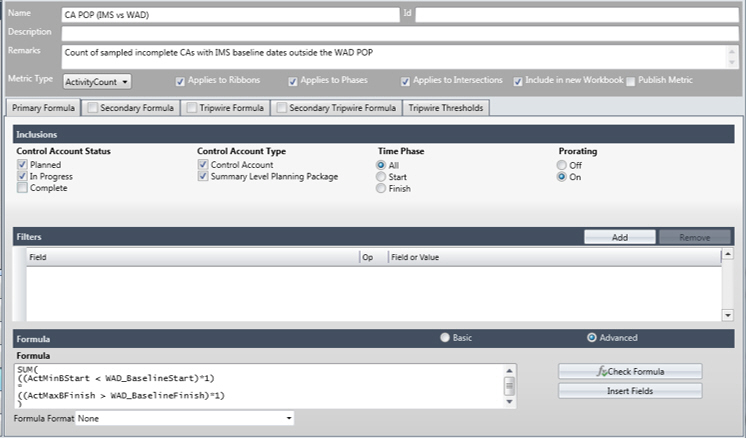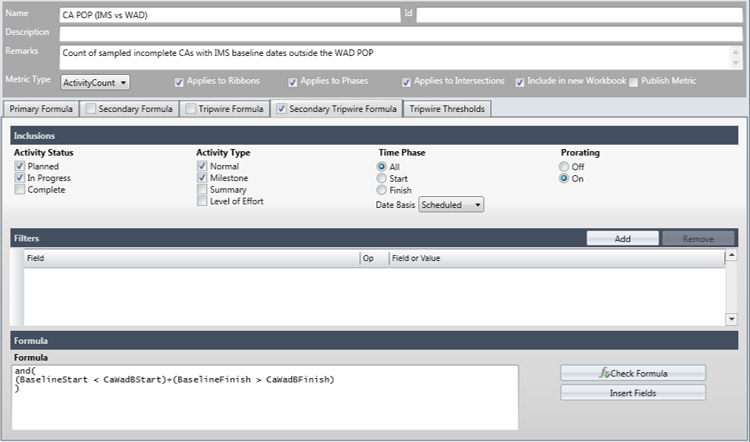Primary and Secondary Tripwire Formulas
Tripwires graphically depict when a particular metric threshold is reached.
Acumen tripwires are flexible with regards to:
- The number of thresholds per metric that can be defined.
- The type of thresholds (absolute and gradient).
- The formulas against which thresholds can be based (primary and secondary).
Tripwire Formulas
The tripwire formula is optional. It is used to determine the individual exceptions that are listed in the Activity Browser. Tripwire formulas get applied to each activity separately, whereas primary and secondary formulas get applied to groupings of activities, work packages, or control accounts (depending on the ribbon, phase, or intersection context).
Tripwires are a very useful means of graphically depicting when a particular metric threshold is reached. Acumen tripwires are flexible with regards to the number of thresholds per metric that can be defined, the type of thresholds (absolute and gradient) and the formulas against which they can be based (primary and secondary).
When creating or editing any of the metric formulas, you can use the Check Formula button to validate the syntax of the formula. Note that when using the Check Formula button, the test calculation is applied to all activities, work packages, or control accounts within the workbook.
Writing the tripwire formula is simpler than writing the primary or secondary formulas as it is not an array formula, but a classic MS Excel cell formula.
Tripwire formulas must return a Boolean (for each activity) in the form of either a True or False value. The most commonly used function to return this Boolean is an AND statement.
- AND(ActivityType="Normal", ActivityStatus="Planned")
AND functions can contain an unlimited number of conditions.
Metrics that do not contain a Threshold formula cannot be used to display activities in the Activity Browser and also cannot be used in the Comparison Analyzer.
- Auto Calculated by Primary Formula — If the primary formula was created using the basic mode, you can opt to automatically create the tripwire formula without defining any exclusions, filters or formulas for the tripwire definition. Instead, Acumen will automatically create a tripwire formula based on the exclusions and filters defined in the primary formula. This mode cannot be used if the primary formula was created in Advanced mode. In this mode, the tripwire exclusions and filters options are disabled as they are not needed in light of the fact these settings are automatically inherited from the primary exclusions and filters.
- Advanced — This mode enables you to manually create exclusions, filters and advanced functions that together return the required set of activities, work packages, or control accounts.
Secondary Tripwire Formulas
The Secondary Tripwire Formula tab is only available for control accounts and work packages. The secondary tripwire formula always looks at activities, regardless of whether you are using a control account or work package metric. Its purpose is to find the activities that are causing the work package or control account an issue.
In the example below, we want to know the number of control accounts that have activities that are outside of the dates that were authorized in the WAD. The metric uses activity calculated fields to find the earliest baseline start and the latest baseline finish and compares them to the WAD baseline start and WAD baseline finish.

When you review the data, it tells us that we have three control accounts that meet the criteria. That gives us a general idea of where the problems lie but we need to drill down further in order to pinpoint exactly where the issue is. This is where the Secondary Tripwire Formula comes into play. It allows us to see which activities, by control account, are outside the WAD dates.
